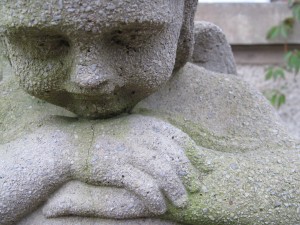“Can’t we as church live into the generosity of God’s story rather than conventional societal fear and constraint?”
Thanks be to God, the lines that separate us are getting blurred these days.
A friend sent me this blog post today about an evangelical woman’s journey toward praying with a rosary.
“I wanted a rosary. I wanted more, too–I wanted the mystery, the beauty of ancient traditions. I wanted works of art in stone cathedrals, the scent of incense reminding me of the presence of a holy God, the sign of the cross made over my head and shoulders. I wanted wine from a deep chalice, not cheap Welch’s grape juice served in disposable plastic cups. But mostly, it was about prayer.”
The lines between differences in spiritual practices among Christian traditions are getting blurry. Thanks be to God.
Why is it that we think the Truth is so small or so fragile that it can only be approached or accessed in certain ways anyway? That the borders of our specific traditions need to be defended? Isn’t the most vigilant person generally the least secure? It seems to me that Truth is way bigger than any of my categories anyway. Look how long it has lasted in the midst of all the distortions we’ve thrown its way.
Jesus saw the church as an ever-expanding force (Matthew 16:17-19) that the gates of Hades could not hold back. Is it not better to trust in that force and expansion even if our choice to blur the lines gets us in trouble a time or two?
Richard Rohr noted today that
“We now know from cultural studies and historical experience that groups define themselves and even hold themselves together largely negatively—by who they are not, what they are against, and what they do not do. We need a problem or an enemy to gather our energies.”
Isn’t there another Way? Can’t we as church live into the generosity of God’s story rather than conventional societal fear and constraint? Is there a way to stay so centered in the sweet spot of the good news that the borders can wisely and freely expand with each whim and breath of the Spirit without fear?
It seems to me that Jesus continually lived that expanding Kingdom vision and kept blurring the lines for folks. Even in his genealogy (Matthew 1), two of the women were non-Jews (Ruth from Moab and Rahab). He also very intentionally redefined family (Luke 8:19-21) as those who do God’s will, an extremely radical notion in a culture where connection to biological family meant survival.
Interestingly, seldom do we see Jesus’ followers doing the same. In fact, they struggled to grasp what he was doing. When Jesus spoke to the Samaritan woman, another taboo, his disciples were surprised and silent.
But one follower of Jesus, the woman from Syro-Phoenicia (Mark 7), stands out as a brilliant exception. She embraced Jesus’ willingness to blur the lines and used it for the sake of healing.
24 Jesus left that place and went to the vicinity of Tyre.t He entered a house and did not want anyone to know it; yet he could not keep his presence secret.25 In fact, as soon as she heard about him, a woman whose little daughter was possessed by an impure spirit came and fell at his feet.26 The woman was a Greek, born in Syrian Phoenicia. She begged Jesus to drive the demon out of her daughter.
27 “First let the children eat all they want,” he told her, “for it is not right to take the children’s bread and toss it to the dogs.”
28 “Lord,” she replied, “even the dogs under the table eat the children’s crumbs.”
29 Then he told her, “For such a reply, you may go; the demon has left your daughter.”
30 She went home and found her child lying on the bed, and the demon gone.
For many years I have struggled with this story. I was so focused on the shocking words of Jesus that I failed to see the woman at all. I neglected to recognize the fact that her presence in the room, before any request was made, was a miracle in itself. Jewish Rabbi’s did not talk to Gentiles, especially Gentile women. And grant a request? Why would she even try? How did she even get into the room? All the boundaries of division in her society said don’t even try.
And yet she came. She had heard of Jesus, maybe also of his mercy. Or, she might have come out of sheer desperation. Or maybe because she had heard that Jesus was a Rabbi who blurred the lines a bit. Whatever her reason, Matthew’s version of the story indicates that Jesus labeled her coming and stubborn pleading, even in the face of his apparent support of the old lines, “great faith.” And let’s not forget that in both gospels this story sits right after Jesus’ radical new teaching on clean and unclean.
The lines are getting blurry. Young women of old and today are finding healing in the process. The Kingdom is expanding. Thanks be to God.
Have you ever found healing in the blurring of lines?












